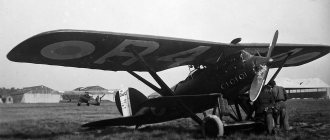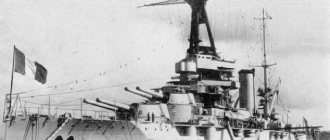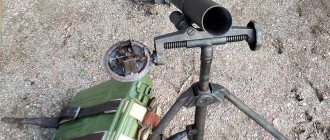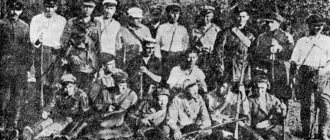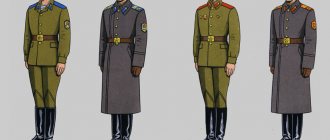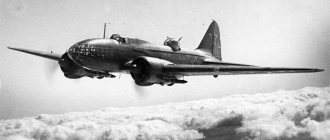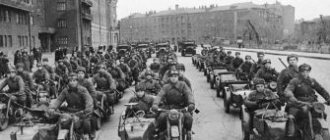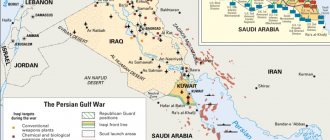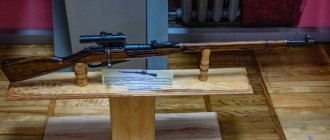4.6
Average rating: 4.6
Total ratings received: 92.
4.6
Average rating: 4.6
Total ratings received: 92.
The Battle of Verdun in 1916 was called the “Verdun Meat Grinder”. It lasted 10 months and became one of the most difficult operations of the First World War, as an example of a war of attrition and enormous losses.
1916 Campaign on the Western Front
By the beginning of 1916, the Kaiser's Germany no longer had the strength for a major offensive, and therefore the command decided to strike in one small area. It became a ledge near the city of Verdun in the eastern part of the front. According to the command's plan, to break through the front it was necessary to encircle and defeat the French divisions, and then strike at the rear of the French army. The front section was only 15 kilometers, on which 6.5 German divisions were opposed by 2 French ones.
Rice. 1. Battle of Verdun.
Campaign goal
In a report on the Battle of Verdun for a report and abstract, it is necessary to determine the cause of the battle. After successive battles in 1914-1915, Germany did not have sufficient resources for a large-scale attack, as a result of which the head of the German General Staff, Erich von Falkenhayn, decided to deliver a crushing blow to the strategically important area of \u200b\u200bVerdun. This move by the Germans was far-sighted for several reasons:
- this territory was well fortified and could serve as cover;
- a narrow protrusion of land seemed to jut into the German positions, so its encirclement and conquest by the “Huns” could have a decisive advantage for them.
The capture of the Verdun region and the destruction of the French divisions located there opened the road to Paris, which would also lead to a certain psychological turning point. Control over this territory would allow Germany to strike at the flank of the troops defending the capital, which, in the opinion of the German command, should have ended in the victory of their troops along the entire western front and the forced surrender of France. The code name for the main operation is "Gericht" ("Justice").
Great hopes were placed on artillery training, which had no equal in history, and the use of specialized groups (attack aircraft).
Progress of the battle
The start date of the battle was February 21, 1916. The Germans launched an offensive in dense combat formations. They divided one battalion into three chains, which attacked at a distance of 100 meters from each other. The advance was supported by artillery. Its task was to suppress another French position in the daytime. In the evening it was to be occupied by infantry. During the first four days of fighting, the French surrendered almost all fortifications and forts.
However, the Germans failed to develop their success. Firstly, the French were able to use the highway leading from Verdun to the south. Almost 200 thousand reinforcement soldiers were transferred along it to the city. As a result, they achieved 1.5 times superiority in manpower.
Reinforcements were transferred along the “Sacred Road” Verdun-Bar-le-Duc.
The Battle of Verdun took place not only on land, but also in the air. At first, the Germans managed to clear the sky of French aviation, but in May 1916 the French sent a squadron of Nieuport fighters to this section of the front.
Rice. 2. Battle of Verdun map.
At the beginning of June, the German army was able to occupy Fort Vaux, but by the 23rd its offensive had ceased.
The last stage of the battle for Verdun lasted from July 1 to December 17. Due to the Anglo-French offensive on the Somme River, on another section of the front, the Germans were forced to withdraw some of their artillery from Verdun. The final blow during the battle was delivered by the French on December 15-17. They managed to push the Germans back 7.5 kilometers from Verdun and take 11 thousand prisoners and 115 captured guns.
The French army in this battle was commanded by Henri Pétain and Robert Nivelle, and the German army by Erich von Falkenhayn and Paul von Hindenburg. The main outcome of the Battle of Verdun was the collapse of the German plan for the 1916 campaign. As in 1914, it was not possible to bring France out of the war. Germany's military potential began to dwindle. The front line was on the lines of February 1916. The losses of both sides amounted to about a million soldiers, of whom about 40% died.
The French were helped by the Russian army's 1916 offensive on the Eastern Front. Near Lake Naroch in March, in Galicia in summer-autumn and near Baranovichi in July. Because of them, some divisions began to be transferred from the Western Front to the east.
Rice. 3. Verdun 1916.
Operation Gericht
It must be said that the head of the German General Staff, General Erich von Falkenhayn, initially considered the French Front a priority. It was decided to carry out the operation near Verdun at the beginning of 1916, since Falkenhayn was sure that France was on the verge of disaster. Both militarily and economically, it has exhausted absolutely all its reserves. And it is customary to finish off a wounded animal. And after a powerful blow, Paris would simply have no reason (as well as resources) to continue resistance.
There was no point in launching a large-scale offensive along the entire Western Front, since the French were little inferior to the Germans. And their fighting spirit was very high. A crushing blow to the “pain point” was required. And Erich von Falkenhayn chose Verdun. He believed that a long-term defense in this area was impossible, since artillery was to play the dominant role in the operation. No fortress could hold out for long under heavy fire without the support of field troops. And to make the task easier, Falkenhayn narrowed the breakthrough front as much as possible (as far as possible, of course).
This is interesting: Erich von Falkenhayn himself believed that it would not be possible to break through to Paris thanks to the Verdun operation. He demanded precisely “to open the gates, but not to enter them.” According to the military leader’s idea, the enemy command, in order to “plug the hole,” would send more and more reserves into the “meat grinder.” And Verdun was supposed to turn into “a pump for pumping out the blood of the French army.” That is, the head of the General Staff did not expect victory from his soldiers. They were simply required to destroy enemy soldiers (preferably with artillery fire) and wait until France had spent absolutely all its reserves.
It must be said that not everyone in the German command liked Falkenhayn’s plan. For example, one military leader from the General Staff, Heinrich von Bauer, fiercely criticized Erich. He recalled the successful captures of Liege, Kovno and Novogeorgievsk precisely with the help of quick and impetuous attacks. Von Bauer openly said that a “meat grinder” was not suitable in this situation, since France had powerful troops and impressive reserves. In his opinion, Verdun had to be taken with lightning speed and the breakthrough front expanded. But Bauer's plan did not receive support, Falkenhayn conducted. Therefore, in the opinion of his comrades, only he himself was to blame for the failure of the operation. And after the Brusilov breakthrough, Falkenhayn was removed from his post as Chief of the General Staff.
Losses of the parties
The total number of soldiers on a surprisingly small section of the front was enormous. France sent a total of 75 divisions here - about 1.14 million soldiers and officers. Germany, trying to suppress the enemy at any cost, even surpassed it - although there were only 50 divisions, due to the difference in equipment, approximately 1.25 million soldiers fought in the trenches near Verdun.
The losses were horrific - from bullets, shells, gas, fire, as well as disease and hand-to-hand combat.
Over 10 months, more than 160 thousand French and 143 thousand Germans died. The total losses amounted to 300 thousand - the population of a large modern city. It was thanks to this that the Battle of Verdun received its second, unofficial name - the Verdun Meat Grinder. We have already briefly described the main stages. What did this operation achieve?
The beginning of the battle in the area of the Verdun fortified area
As is already clear from the preparations, the “Verdun Meat Grinder” was predetermined by the German command from the very beginning. In the morning, the Germans began artillery preparation, which lasted 8 hours, after which the German troops went on the offensive on one of the sectors of the front - near the Meuse River. But stubborn French resistance awaited them there. The Germans led the infantry offensive in a dense battle formation, in which individual groups were formed into a single echelon. Moving ahead were scouts and assault brigades, reinforced with grenade launchers, machine gunners and flamethrowers. Thus, the “Verdun Meat Grinder” on the first day was marked by the advance of German troops two kilometers behind the French lines and the occupation of their first position.
How the Russians saved Paris
Perhaps in March 1916, in fact, at the very beginning of the Verdun operation, the Germans had the opportunity to break through the enemy’s defenses and reach practically defenseless Paris. The German Empire carefully prepared reserves, preparing to transfer them to the most important sector of the front. A sharp increase in the number of soldiers would certainly make it possible to break through the defensive positions.
Concerned politicians and generals literally begged the Russian allies to take appropriate measures. And Nicholas II went to meet them halfway. Due to the short time frame, it was practically impossible to plan the operation. The offensive was prepared very poorly, as a result of which the operation near Lake Naroch ended in serious losses for the Russian Empire - the ground was literally saturated with Russian blood. But German strategists, fearing a second breakthrough, were forced to transfer carefully collected reserves to the Russian front, and not to break through the defenses near Verdun. This provided the French allies with breathing space, giving them hope of victory.
sacred road
The Sacred Road played a significant role in the victory of France. Only by miracle did the defenders manage to save it, preventing the Germans from capturing the vital artery connecting Verdun and neighboring Bar-le-Duc. It was along this route that at least 190 thousand people, as well as about 30 thousand tons of equipment and ammunition, were transferred during the first week of battles.
If the Germans knew about the importance of this road (and they most likely knew - reconnaissance worked perfectly) and had the opportunity to destroy it, then the heroic defenders would have been able to hold out for no more than a few weeks. But history took its own course.
Technical news
During the Battle of Verdun, the Germans used a large number of technical innovations in battle. Of course, one of the most effective and spectacular was the flamethrower. A terrible weapon that does not kill immediately, but burns a person alive, had a huge impact on the enemy’s combat potential. Near Verdun, many cases were recorded when defenders abandoned their positions and fled in horror as soon as they saw approaching flamethrowers. In addition, flamethrowers showed excellent performance in clearing both trenches and pillboxes, which are extremely difficult to deal with using conventional small arms.
Military gases were also developed and tested in practice, which had a huge impact on the nature of subsequent wars.
Hundred Day Offensive
This offensive, lasting one hundred days, was a series of Allied offensives. It began in August 1918 and lasted until the month of November. The Germans then managed to advance deep into France. They approached Paris itself. There were only 75 km left to the city.
But they lacked ammunition and supplies to quickly capture Paris. At this time, the Allies were mobilizing soldiers and collecting artillery in Amiens. The French managed to regain 13 km of their territory in one day. German troops were pushed back behind the Hidenburg Line. Then, on November 13, 1918, an armistice was signed, which marked the end of the First World War. The final battle of the Hundred Days Offensive is of great significance. This victory came at a high price. Then 1 million died. 800 thousand people. 7 million people were wounded in the battles.
Battle of the Somme
The Battle of the Somme was a very important stage of the First World War. It was supposed to ease the pressure on the French forces that were fighting at Verdun. Just before the battle began, the German lines were broken. But the British failed to truly take advantage of this. Having advanced very little on July 1, 1916, they became a good target for the Germans. But they did not stop the offensive. During the battle on November 18, 1916, they managed to advance almost 10 km. About 600 thousand British soldiers died then. On the first day alone, 20 thousand were killed. The Germans also had heavy losses. More than half a million people died on their side. In total, more than a million people died in the Battle of the Somme.
Battle of Passchendaele
This was the Third Battle of Ypres. It began on July 31 and ended on November 6, 1817. Bloody battles continued for three months. The British managed to recapture the village of Passchendaele, which was located near Ypres. Then there were numerous losses on both sides. General Douglas Haig was confident that the Germans were close to collapse, so a strong push could lead to victory. On July 31, the British infantry offensive began. But a heavy downpour began, the most powerful in the last 30 years. The whole earth became a complete swamp. The rain destroyed all drainage systems. Not only people, but also horses were stuck in the slurry. Attacks in the following months made little progress. Only after the capture of the village of Passchendaele did the offensive become successful.
Who fought whom?
The battle, which took place in the middle of World War I, was fought between the German Empire and France.
The French troops were led by commanders Robert Nivelle and Henri Pétain. Their German opponent was Eric von Falkenhayn. It was under their leadership that the most terrible and bloody battle that the First World War had ever known unfolded - the Verdun Meat Grinder.
Brusilov breakthrough and the final situation at Verdun
On June 7, the Germans attacked and captured Fort Vaux, advancing 1 kilometer into French territory. The offensive could have been continued, but in the summer of 1916, Russian troops prepared an unexpected surprise for the German army: a powerful offensive began near Lutsk. It was impossible to contain the attacks. As a result, German troops were diverted to the Eastern Front for the entire summer, and actions near Verdun were reduced to a minimum. In addition, unlike the spring campaign, Russian troops won a real victory and occupied Eastern Galicia and Bukovina. In addition, the operation called “Brusilovsky breakthrough” was a completely new type of offensive action. German troops were weakened and forced to go on the defensive on the Western Front. In October, the French army went on a clear offensive, and by December it returned to its positions where it was at the beginning of the battle. The Verdun meat grinder is over.
Preparing for battle
The offensive was planned on a small section of the front about 15 km long. The troops were commanded by Crown Prince Wilhelm himself . At that time, there were only 2 French divisions in the vicinity of Verdun, which had to resist 6 German divisions. Huge artillery power was also concentrated there: 1225 guns, including 420-mm mortars (the famous “Big Bertha”), and 152 mortars. Airplanes were deployed to correct the guns.
Each side sought to ensure air superiority. All preparations were carried out secretly, despite the fact that the deployment of artillery took several months. Henri Pétain, an outstanding French military leader who is still celebrated (despite his collaboration with the Nazis 25 years later) as the Verdun winner, later recalled that the German training was brilliantly organized and carried out completely unnoticed.
According to French intelligence, an enemy offensive in the Verdun area was considered likely, so orders were given to strengthen the position.
Historians disagree on whether sufficient measures were taken to deter a possible attack. In total, the French and their allies built four lines of defense on the banks of the Meuse River within a radius of several kilometers from the fortress.
Results and significance of the Battle of Verdun
The Verdun Meat Grinder of 1916 did not solve any strategic or tactical problems: the French troops took up their own positions. But, if you count the losses, the battle of Verdun exceeded all expectations. Both sides lost more than 1 million troops, of whom about 430 thousand were killed. Verdun in 1916 ushered in the brutal era of warfare in the 20th century. But there were still results: the German strategic plan collapsed at Verdun. And from this moment on, military historians note the depletion of German military potential. We also note that in the battle of Verdun, chemical shells, light machine guns, flamethrowers and rifle grenade launchers were used for the first time. Also, for the first time, the regrouping of troops by road transport was tested, assault groups were created, the density of artillery shelling increased, and air assault operations were used.

